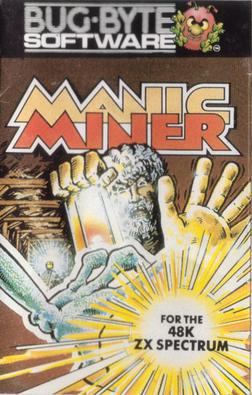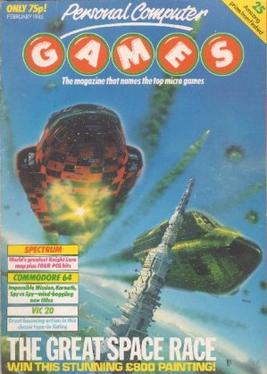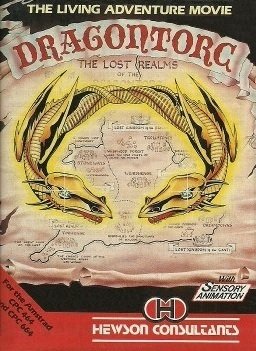
Manic Miner is a platform game written for the ZX Spectrum by Matthew Smith. It was published by Bug-Byte in 1983, then later the same year by Software Projects. The first game in the Miner Willy series, the design was inspired by Miner 2049er (1982) for the Atari 8-bit computers. Retro Gamer called Manic Miner one of the most influential platform games of all time, and it has been ported to numerous home computers, video game consoles, and mobile phones.

Sabre Wulf is an action-adventure game released by British video game developer Ultimate Play the Game for the ZX Spectrum home computer in 1984. The player navigates the pith-helmeted Sabreman through a 2D jungle maze while collecting amulet pieces to bypass the guardian at its exit. The player does not receive explicit guidance on how to play and is left to decipher the game's objectives through trial and error. Sabreman moves between the maze's 256 connected screens by touching the border where one screen ends and another begins. Each screen is filled with colourful flora, enemies that spawn at random, and occasional collectibles.

Knight Lore is a 1984 action-adventure game developed and published by Ultimate Play the Game, and written by company founders Chris and Tim Stamper. The game is known for its use of isometric graphics, which it further popularized in video games. In Knight Lore, the player character Sabreman has forty days to collect objects throughout a castle and brew a cure to his werewolf curse. Each castle room is depicted in monochrome on its own screen and consists of blocks to climb, obstacles to avoid, and puzzles to solve.

Colossal Adventure is a text based adventure game published by Level 9 Computing in 1982. It was originally released for the Nascom.
Newsfield Publications Ltd was a British magazine publisher during the 1980s and early 1990s.

Zzap!64 is a computer games magazine covering games for computers manufactured by Commodore International, especially the Commodore 64 (C64). It was published in the UK by Newsfield Publications Ltd and later by Europress Impact.

Rush'n Attack, also known as Green Beret in Japan and Europe, is a run-and-gun and hack-and-slash video game developed and released by Konami for arcades in 1985, and later converted to the Nintendo Entertainment System and home computers. Its North American title is a play on the phrase "Russian attack" due to its Cold War setting. It was ported to home systems and became a critical and commercial success for arcades and home computers.

Eureka! is a video game for the Commodore 64 and ZX Spectrum computers, written by Ian Livingstone, developed by Novotrade for Andromeda Software and published by Domark in 1984.
Pete Cooke is a British computer games programmer, best known for his work published in the 1980s for the ZX Spectrum.

Tornado Low Level is a multidirectional flight game developed by Costa Panayi and published in 1984 by the company he co-founded, Vortex Software. The game was first released for the ZX Spectrum, and later ported to the Amstrad CPC and Commodore 64.

The Heroes of Karn is a 1983 adventure game written by Ian Gray. It was released by Interceptor Micros for the Commodore 64, Amstrad CPC and ZX Spectrum. Music was written by Chris Cox. The Spectrum and Amstrad versions were adapted by David M. Banner with graphics by Terry Greer. A sequel, Empire of Karn, was released in 1985 on the Commodore 64.

Oh Mummy is a video game for the Amstrad CPC models of home computer. It was developed by Gem Software and published by Amsoft in 1984. It was often included in the free bundles of software that came with the computer. The gameplay is similar to that of the 1981 arcade game Amidar.

Personal Computer Games was a multi-format UK computer games magazine of the early/mid-1980s published by VNU.

Dandy is a dungeon crawl maze video game for Atari 8-bit computers published by the Atari Program Exchange in 1983. It is one of the first video games with four-player, simultaneous cooperative play. Players equipped with bows and unlimited arrows fight through a maze containing monsters, monster spawners, keys, locked doors, food, and bombs in search of the exit leading to the next level. If a player dies, they can be revived by finding and shooting a heart. The game includes an editor for making new dungeons.

Splat! is a maze video game published for the ZX Spectrum in 1983 by Incentive Software of Reading, England. It was subsequently released for the Amstrad CPC, Commodore 64, and SAM Coupé.
Red Shift was a video game publisher active between 1983 and 1985. They were well known for their strategy games and had a close working relationship with Julian Gollop and Games Workshop.

SoftAid is a software compilation, released by Quicksilva in March 1985 to support the Famine Relief in Ethiopia. The software was released on cassette for the ZX Spectrum and Commodore 64 home computers. Versions were also planned for the Amstrad CPC and BBC Micro but Rod Cousens, Quicksilva's Managing Director, was unable to secure enough games from publishers.

Dragontorc is an action-adventure game developed by Steve Turner's Graftgold and released for the Amstrad CPC and ZX Spectrum by Hewson Consultants in 1985. It is a sequel to 1984's Avalon The 3D Adventure Movie. The hero of Avalon, Maroc the Mage, returns to defeat an evil witch and save Britain. The game was well received by critics.
Dark Star is a 1984 ZX Spectrum shoot 'em up developed and published by Design Design. It was later ported to other home computer platforms including the Amstrad CPC, TRS-80 Color Computer, and Dragon 32/64 in 1985.














